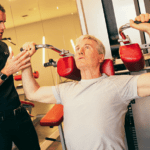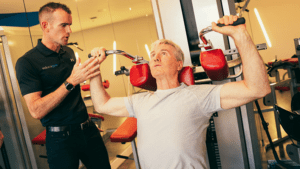Without question, how you stand, walk, sit, sleep, and move every day (and night) will give you the biggest results in creating a strong and aligned core.
Good posture does NOT mean holding your body stiff, with rigid shoulders and a fully-braced core.
Instead, it’s about having core muscles that are strong enough to hold your spine in alignment while you’re relaxed (yes, it’s possible!).
This is important because poor posture doesn’t only cause aches and pains, but it can affect the long-term health of your spine and joints. We have learnt that it also plays a role in your breathing and digestion.
So, WHAT IS A GOOD POSTURE?
There are actually TWO kinds of posture.
- DYNAMIC POSTURE is how you hold your body when you are moving – walking, doing chores, exercising, etc.
- STATIC POSTURE is how you hold your body when you’re not moving – when you’re sleeping, sitting, or standing.
Both matter!
Your spine is the key to your posture. It has three natural curves – at your neck, mid-back, and low back.
Your head should be above your shoulders, and the top of your shoulders should be over the hips.
Good posture keeps these curves at their perfect angle.
QUICK TIPS TO IMPROVE YOUR POSTURE WHEN SITTING AND STANDING
When standing, make sure your:
- Shoulders are back, stacked over your hips.
- Ab muscles are engaged.
- Knees are soft (not locked).
- Hips are in a neutral position – not tipped back (sticking your butt out) or curled under.
- Head is level.
- Arms are hanging down naturally at your sides.
- Feet are shoulder-width apart.
When sitting:
- Your chair should support your back. Use a pillow if your chair doesn’t have a backrest that supports the natural curve of your lower back.
- It should also support your thighs and hips. You should have a padded seat, and when you sit your thighs and hips should be parallel to the floor, and your feet touching the floor. If your chair or desk is too tall for you, you can place a footrest under your feet.
- Keep your shoulders relaxed. Make sure they aren’t rounded forward or pulled back.
- Avoid crossing your legs.
- Switch sitting positions to avoid muscle tension.
- Take brief walks every hour.
- Gently stretch your muscles every hour or so to help relieve muscle tension
Bad posture over time can place a strain on your muscles and other soft tissues, resulting in muscle imbalances and also affect your core. Therefore maintaining a good posture is vital for health, wellness and boosting your performance.
We’re all about helping you develop simple (but life-changing!) habits to create change and transform your life. If you would like to learn more about improving core strength, dive into our blog page and read more blogs on CORE STRENGTH.
If you want to act now to improve your posture in particular, you can also sign up to our free Stronger to the core challenge here <<—







